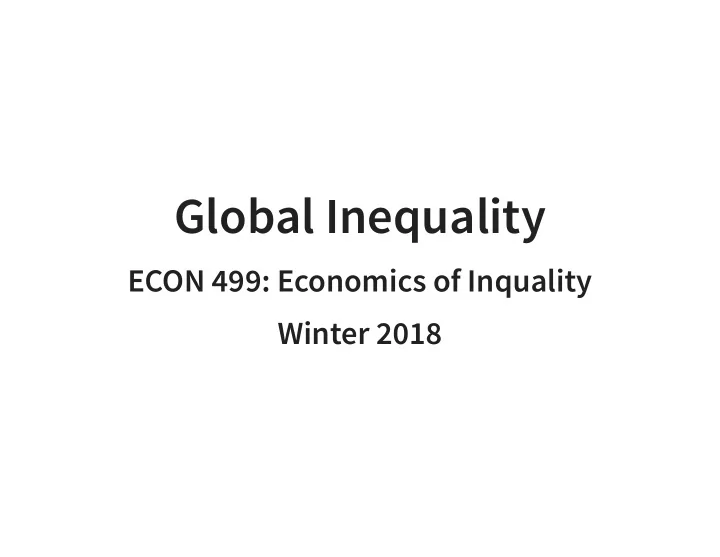

Global Inequality ECON 499: Economics of Inquality Winter 2018
1820 1929 1950 1960 1970 1980 2000 100 100,000 Income per world citizen per year (in 1990 International Dollars) The author Max Roser licensed this visualisation under a CC BY-SA license. You are welcome to share but please refer to its source where you find more information: www.ourworldindata.org/data/growth-and-distribution-of-prosperity/inequality-between-world-citizens/ Data Source: van Zanden et al. (eds.) (2014) – How Was Life?, OECD.
1988 1993 1998 2003 2008 2011 Stacked Stream Expanded Developed Countries Sub-Saharan Africa Russia, Central Asia, SE Europe and Middle East & Northern Africa Latin America & Caribbean Other Asia India China The y-axis is scaled such that the total area under the graph corresponds to the total regional (or global) population (of those countries that are included in the database) Yearly Income per Person (in PPP-adjusted 2005 US$; on a logarithmic axis) This visualisation is licensed under a CC BY-SA license. You are welcome to share but please refer to its source where you find more information: ourworldindata.org/data/growth-and-distribution-of-prosperity/inequality-between-world-citizens/ Citation to the paper: Global Income Distribution: From the Fall of the Berlin Wall to the Great Recession, Christoph Lakner and Branko Milanovic, World Bank Economic Review, Advance Access published August 12, 2015. Data Visualization by Max Roser and Zdenek Hynek
How does growth a ff ect inequality? Does inequality go up or down as countries get richer? Kuznets: Inequality goes up, then goes down
Source: World Bank
Growth and inequality In the cross section it does not appear the wealthier countries have lower inequality We would like know how inequality evolves as countries develop We don't have great data on this! Piketty, Saez, Zucman (and others): World Wealth and Income Database
Growth and inequality Growth doesn't appear to make top incomes diverge among developing countries What about low income? Are people "le � behind" by development? We can look at poverty rates
Source: Deaton (2013)
Poverty Poverty has fallen dramatically at a global level Poverty reductions in China and India (35% of global population) are important cause Poverty in sub-Saharan Africa has not changed much
Between-country inequality Global inequality has been falling Within-country inequality has been (relatively) constant Between country inequality must be falling Poor countries must be growing faster than rich countries
Exponential growth "Rule of 70" Imagine income grows at an exponential rate g% per year Income will double in 70/g years USA: g=2.5% average income doubles every 28 years (the average → person has twice as much income as their parents at the same age) China: g=7% average income doubles every 10 years → Lucas (1988): "Once one starts to think about [economic growth], it is hard to think about anything else."
Solow growth model Workers consume part of their income, save the rest Savings are capital investments for firms (banks loan out savings) Capital is productive, makes workers more e ff icient wages increase → Workers save more, causing capital to increase, etc… Diminishing marginal returns to capital: Eventually additional capital will not have much of an e ff ect on productivity, growth levels o ff "Steady state:" Capital and income grow at a constant rate, determined by technological growth
Convergence Technology is easily transferable, so steady state growth should be the same in every country Countries with below steady-steady state capital should grow faster than countries at steady state Poor countries should grow faster than rich countries
Conditional convergence Countries that are similar to each other tend to converge in income What are those similarities? Politics, education, institutions, technology, etc
Summary Decreases in inequality at global level driven by India and China Solow model predicts growth of middle income countries will eventually slow down (converge) Poor countries may be "le � behind" unless they figure out how to grow Low growth rates in poor countries means that the gap between rich and poor will get larger over time
Recommend
More recommend